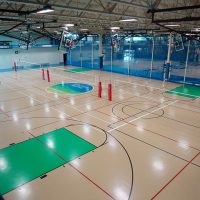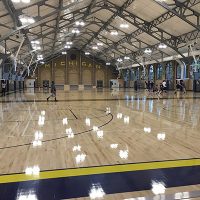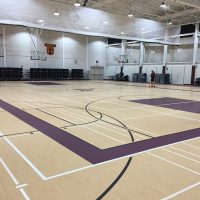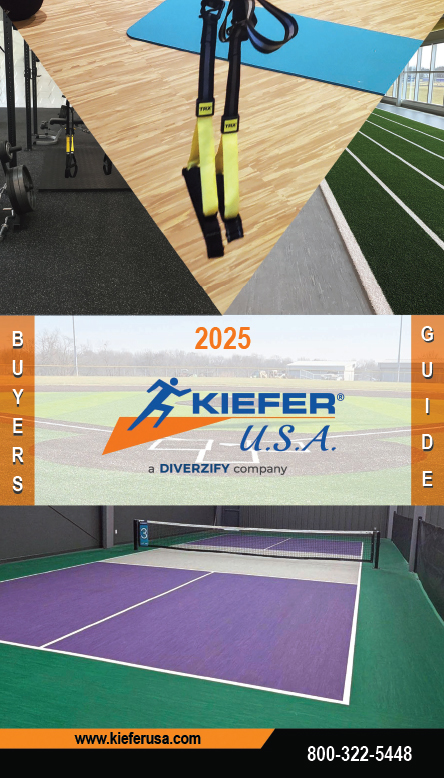Track and field is a sport that has roots in prehistoric times and was a featured event in the Panhellenic Games in ancient Greece. It continues to be a staple of the modern Olympic Games and a popular sport at grade school, high school, and collegiate levels. Over the years, the materials and technology of track surfaces have evolved to provide better traction and support for improved athlete performance and a lower risk of injuries. The technology for indoor tracks has also improved, allowing training and competitions to be moved indoors.
Indoor track and field surfaces allow athletes to train indoors and avoid cold, wet, or inclement weather. Indoor venues also make great venues for competitive track and field events as spectators can watch the event comfortably without worrying about the weather. Another advantage of indoor track and field surfaces is that they can be used in multipurpose facilities while outdoor tracks are unusable during the winter.
In this guide, we answer some of the most common questions people have regarding indoor track and field surfaces, including questions about the materials used for indoor tracks and the types of tracks used in indoor facilities.
What are the differences in the design of indoor tracks and outdoor tracks?
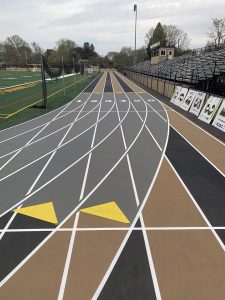 There are several design aspects that may differ between indoor tracks and outdoor tracks including space, dimensions, materials, customization, and banked turns.
There are several design aspects that may differ between indoor tracks and outdoor tracks including space, dimensions, materials, customization, and banked turns.
Space
The first thing to consider is the amount of space you have available to install an indoor track. A facility should have space for the track itself, warm up areas for athletes, and spectator seating if your facility hosts competitive events. If your club or school must build a new facility to house an indoor track, you should decide whether you want an 8-lane or 4-lane track and whether the track should be 200 meters, 300 meters, or the standard 400 meters. Determining the size and dimensions of the track first will ensure that the new facility is built to fit the track.
If you want to add an indoor track to an existing facility, the space within the facility will dictate the size and dimensions of the track. You may also have to make the following renovations to the facility to better accommodate indoor track and field training and events:
- Improve air quality: Upgrading the ventilation and air filtration system will create a safer and more comfortable environment.
- Lighting: Powerful, energy efficient lighting will benefit competitors.
- Storage: Adding extra storage space will make it easier to store equipment and supplies.
Dimensions
The dimensions of an outdoor track are 8 lanes, 400 meters. However, indoor venues may not have the space for a track this size. Depending on the space available, you can install an indoor track that is 4, 6, or 8 lanes in 200-meter, 300-meter, and 400-meter formats. It helps to consult a professional like Kiefer USA to determine the best dimensions for an indoor track for your specific space.
FAQ
How much space is needed for an indoor track?
The amount of space needed for an indoor track will depend on the number of lanes and distance. A standard 8-lane, 400-meter track requires 157,092 square feet of space, a standard IAAF or NCAA indoor track with 6 lanes and 200-meter format requires 78,546 square feet of space, and a 6-lane, 300-meter running track requires 110,922 square feet of space.
What Materials is an Indoor Track Made Of?
Indoor track surfaces are generally made from rubber or polyurethane which are both durable materials. There are lower quality and higher quality options for both materials, so the materials you choose should depend on the level of performance needed from the track. You can choose lower quality rubber or polyurethane for an indoor track at a community center while track surfaces used in competitions at schools should be made from higher quality materials.
You should choose the best quality materials possible for your indoor track because higher quality materials will better endure the wear and tear from regular use. The track surface should also be spike resistant, so you do not have to put equipment restrictions on athletes.
Customization
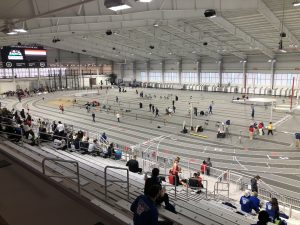 Indoor tracks are more customizable than outdoor tracks which give you the freedom to incorporate the colors and logos of your school or facility in the track design. You can customize your track with the following:
Indoor tracks are more customizable than outdoor tracks which give you the freedom to incorporate the colors and logos of your school or facility in the track design. You can customize your track with the following:
- Colors of the lanes and lines
- Logos and designs
- Arena names
- Signage
Flat or Banked Curve Designs
Outdoor tracks are flat all around while indoor tracks can have flat or banked curve designs. With a banked curve design, the curves of the track have a raised pitch that can be a permanent or modular feature. Banked tracks are preferred for competitions and professional training. If you want to host competitions or provide a space for professionals to train, it is best to install a banked track.
FAQ
Why do indoor tracks have an incline?
Banked tracks have an incline because this helps balance the centrifugal force of athletes as they make their turns. Flat curves do not counterbalance the centrifugal force as athletes take their turns which is why flat indoor tracks are recommended for amateur or recreational use.
What is the difference between fixed banked tracks and variable hydraulic banked tracks?
Fixed bank tracks are indoor tracks in which the incline is in a fixed position while variable hydraulic banked tracks feature an adjustable incline that is set using a PLC system. The following are the four main types of fixed bank tracks:
- Moving tracks: These tracks are supported by a steel structure with plywood panels that is set directly on the floor of the facility. The structure is designed to be easily assembled and dismantled so it can be removed and stored when not in use. They are best for multi-purpose facilities because the track can be easily dismantled and reassembled.
- Tracks that can be dismantled: These tracks are supported by a steel and wood structure that is installed over a shallow pit. Some tracks can be dismantled completely while others can only be partially dismantled. Dismantled tracks are intended for long-term use and are recommended for facilities devoted to athletics that may need to remove the tracks every now and then for a different type of activity or event.
- Permanent steel and wood tracks: These tracks are permanently installed tracks with a steel and wood structure that maintains the dimensions of the track over time. While intended to be permanent installations, these tracks can be easily dismantled when they have reached the end of their life.
- Permanent concrete or asphalt tracks: Tracks made from concrete or asphalt are permanent installations. They are best used for recreational or smaller category competitions because they rarely meet the required dimensions for higher level competitions.
Variable hydraulic tracks use a PLC system that allows for the precise adjustment of the bank in the curves. These tracks feature a permanent steel and wood structure, and the PLC system controls the hydraulic movement so the incline can be set to meet specific requirements for competition. When not in use, the track is retractable and can be set flat to lie flush with the floor, allowing the space to be used for other sports and events with no need to dismantle, remove, and store the track. Hydraulic tracks can be used for professionals and amateur training and competitions.
Indoor Track Surfaces from Kiefer USA
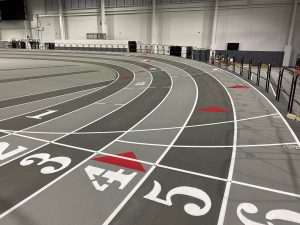 Kiefer USA is a leading supplier and installer of sports flooring and surfaces, including indoor tracks. We offer several quality track surfaces from Mondo made from prefabricated, vulcanized rubber. Vulcanized rubber indoor track surfaces offer the following advantages:
Kiefer USA is a leading supplier and installer of sports flooring and surfaces, including indoor tracks. We offer several quality track surfaces from Mondo made from prefabricated, vulcanized rubber. Vulcanized rubber indoor track surfaces offer the following advantages:
- High level athletic performance
- Elasticity and traction to allow high performance while reducing the risk of injuries
- Easy repairs, maintenance, and cleaning
- Uniform thickness and excellent aesthetics
We offer the following indoor track surfaces from Mondo:
Mondo Super X 720
The Mondo Super X 720 is a high-performance track surface made from vulcanized rubber with a 720 hexagonal backing layer. The backing layer features hexagonal cushions of air that deform to absorb the impact and regain their shape for energy return that provides both comfort and speed to the athlete. The top layer is uniform for more consistent performance, and it has the following advantages:
- Traction: Vulcanized rubber provides excellent traction which allows athletes to use smaller spikes that reduce drag and increase speed.
- Drainage: The uniform texture allows for proper drainage.
- Durability: These tracks have high durability as there are no granules breaking away underfoot.
- Safety: These tracks meet IAAF and ADA requirements even when wet, and they are MRSA resistant.
Mondo Super X Performance
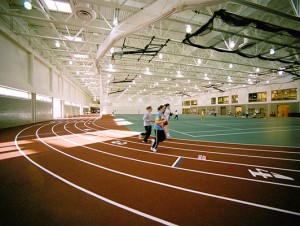 The Mondo Super X Performance track surface features multiple-density surfaces with double durometer construction for a consistent feel. The compartmentalized design has a high potential for deformation which offers maximum energy absorption and return. The vulcanized surface also provides maximum elasticity and minimal deterioration for excellent durability.
The Mondo Super X Performance track surface features multiple-density surfaces with double durometer construction for a consistent feel. The compartmentalized design has a high potential for deformation which offers maximum energy absorption and return. The vulcanized surface also provides maximum elasticity and minimal deterioration for excellent durability.
The following are the main features of the Mondo Super X Performance:
Top layer:
- Surface embossing for better traction
- Effective drainage for high performance in all conditions
- Non-slip surface
Shock absorption layer:
- Consistent biomechanical and physical properties
- Unmatched safety and comfort
Durability and performance:
- Long lifespan
- Stain resistance with no need for coatings or specialized maintenance
- Can withstand static and rolling loads
- IAAF certified
Mondo Sportflex M
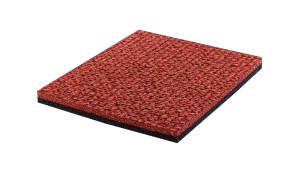 The Mondo Sportflex M track surface is an ideal surface for multi-purpose facilities, and it can be used indoors and outdoors. The following are the main features:
The Mondo Sportflex M track surface is an ideal surface for multi-purpose facilities, and it can be used indoors and outdoors. The following are the main features:
Top layer:
- Engineered with an adjusted coefficient of friction best for sports that require pivot movements
- Improved ball bounce with tessellation pattern texture
- Can withstand heavy traffic and abuse in multi-purpose settings
Shock absorption layer:
- Enhanced vertical deflection and improved lateral support from deforming geometries provides excellent shock absorption and energy return
- Vulcanization process ensures consistent biomechanical and physical properties over its life
Durability and performance:
- Can withstand static and rolling loads including bleachers, tables, and chairs
- Long lifespan
- Excellent stain resistance with no coatings or specialized maintenance required
All of the Mondo indoor track surfaces from Kiefer USA are GreenGuard Gold Certified and 100% recyclable with no CFCs, halogen, plasticizers, chlorine, asbestos, or heavy metals. Facilities that have these indoor track surfaces installed can get LEED points.
How Do You Maintain an Indoor Running Track Surface?
Indoor track surfaces are relatively low maintenance but do still require cleaning to remove built up dirt, residue, and debris. The following tips will help you clean and maintain your indoor track:
- Initial cleaning: The indoor track should be washed after installation and before the first time it is used. Use a floor scrubber with a non-abrasive cylindrical brush with nylon bristles to remove construction dust and production residue. You should not wash the track until at least 72 hours after its installation. For track surfaces with newly painted lines, you should wait at least 30 days before the initial cleaning.
- Regular cleaning: Track surfaces should be vacuumed before and after an event, or at least once per week. Regularly used surfaces should also be washed at least once each week using a low foaming, film-free floor cleaner that requires little to no rinsing. It is best to use a floor scrubber with a non-abrasive cylindrical brush as opposed to a mop.
- Deep cleaning: Deep cleaning should be done as needed, either annually, quarterly, or after events. Use a floor scrubber with a non-abrasive cylindrical brush and a degreaser, heavy duty cleaner, or floor stripper depending on the build up or dirt and other debris on the track. You may have to rinse the track surface multiple times.
Call Kiefer USA for Indoor Track Surface Installation
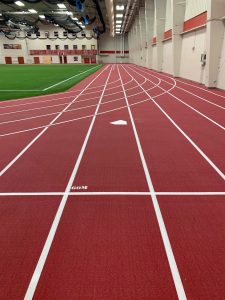 Indoor track surfaces in schools and facilities allow for indoor training away from the inclement weather and competitive events. They are ideal for facilities dedicated to track and field training as well as multi-purpose facilities that want track and field training and competitions to be one of the purposes for the space. Indoor tracks differ in design, dimensions, and materials from outdoor tracks and the best indoor track for your facility depends on how you plan to use it.
Indoor track surfaces in schools and facilities allow for indoor training away from the inclement weather and competitive events. They are ideal for facilities dedicated to track and field training as well as multi-purpose facilities that want track and field training and competitions to be one of the purposes for the space. Indoor tracks differ in design, dimensions, and materials from outdoor tracks and the best indoor track for your facility depends on how you plan to use it.
At Kiefer USA, we supply and install high quality indoor track surfaces for all types of facilities. Our indoor track products include high-performance surfaces from Mondo, and we can provide complete installation for flat and banked curve tracks. Our professionals can also help determine the best indoor track surface based on your facility and your intended use for the track.
You can call Kiefer USA at (800) 322-5448 for more about our indoor track surfaces and installation.

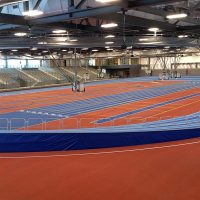
 There are several design aspects that may differ between indoor tracks and outdoor tracks including space, dimensions, materials, customization, and banked turns.
There are several design aspects that may differ between indoor tracks and outdoor tracks including space, dimensions, materials, customization, and banked turns.
 Kiefer USA is a leading supplier and installer of sports flooring and surfaces, including
Kiefer USA is a leading supplier and installer of sports flooring and surfaces, including  The
The  The
The  Indoor track surfaces in schools and facilities allow for indoor training away from the inclement weather and competitive events. They are ideal for facilities dedicated to track and field training as well as multi-purpose facilities that want track and field training and competitions to be one of the purposes for the space. Indoor tracks differ in design, dimensions, and materials from outdoor tracks and the best indoor track for your facility depends on how you plan to use it.
Indoor track surfaces in schools and facilities allow for indoor training away from the inclement weather and competitive events. They are ideal for facilities dedicated to track and field training as well as multi-purpose facilities that want track and field training and competitions to be one of the purposes for the space. Indoor tracks differ in design, dimensions, and materials from outdoor tracks and the best indoor track for your facility depends on how you plan to use it.